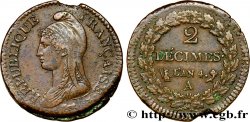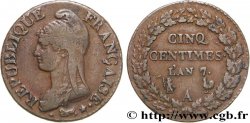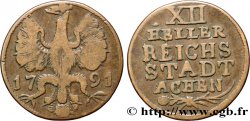fme_481185 - DIRECTOIRE Conseil des Cinq-Cents
Not available.
Item sold on our e-shop (2018)
Price : 150.00 €
Item sold on our e-shop (2018)
Price : 150.00 €
Type : Conseil des Cinq-Cents
Date: 1797
Metal : silver
Diameter : 41 mm
Orientation dies : 6 h.
Weight : 29,25 g.
Edge : lisse
Coments on the condition:
Métal coupé à 12 heures. Patine grise. Usure sur les points hauts. Présence de coups et rayures
Obverse
Obverse legend : REPUBLIQUE - FRANÇAISE.
Obverse description : Faisceau coiffé d’un bonnet phrygien, accosté de branches de laurier et de chêne, cornes d’abondance au pied du faisceau; à l’exergue : REPRES. DU PEUP / L’AN V.; signé : GATTEAUX.
Reverse
Reverse legend : CONSEIL DES CINQ-CENTS // J. B. SELVES.
Reverse description : Ourobouros entourant la CONSTITUTION/DE/L'AN TROIS posée sur un niveau.
Commentary
Cette médaille est réalisée par Nicolas Marie Gatteaux (1751-1832). Elle état remise à chaque membre du conseil pour la session de l'an 5, en l’occurrence Jean-Baptiste Selves (1756-1823). Ce dernier était avocat au Parlement de Toulouse. Il fut député des Cinq-Cents en 1797, élu par son département, mais cette décision fut annulé par les mesures arbitraires qui suivirent la révolution du 18 fructidor an V. Bonaparte le nomma juge au tribunal criminel de la Seine en 1801.
Le Conseil des Cinq-Cents, “chambre basse”, était l'une des deux Assemblées du Directoire. Composé de 500 députés comme son nom l'indique, le Conseil était élu au suffrage censitaire à deux tours, conformément à la Constitution de l'An III, chacun devait être âgé de plus de 30 ans et résidant depuis au moins dix ans sur le territoire national. Les citoyens de chaque canton, hommes majeurs de vingt et un ans, payant une contribution directe ou justifiant de services militaires actifs dans l'armée et résidant en France depuis au moins un an, se réunissaient en assemblées primaires afin de désigner un « grand électeur » pour 200 habitants. Le Conseil avait l'initiative des projets de Loi soumis ensuite au Conseil des Anciens, “chambre haute”. Ses députés dressaient la liste où le Conseil des Anciens devait choisir les Directeurs. Après les élections de l'An V, la majorité thermidorienne disparut. L'Assemblée fut renversée et dissoute par le Coup d'État de Bonaparte le 18 brumaire An 8 (9 novembre 1799).
This medal was made by Nicolas Marie Gatteaux (1751-1832). It was given to each member of the council for the session of year 5, in this case Jean-Baptiste Selves (1756-1823). The latter was a lawyer at the Parliament of Toulouse. He was a deputy of the Five Hundred in 1797, elected by his department, but this decision was annulled by the arbitrary measures which followed the revolution of 18 Fructidor year V. Bonaparte appointed him judge at the criminal court of the Seine in 1801.
The Council of Five Hundred, the “lower house,” was one of the two Assemblies of the Directory. Composed of 500 deputies as its name indicates, the Council was elected by census suffrage in two rounds, in accordance with the Constitution of Year III, each had to be over 30 years old and resident for at least ten years on the national territory. The citizens of each canton, men of legal age twenty-one, paying a direct contribution or having active military service in the army and residing in France for at least one year, met in primary assemblies to designate a \\\"grand elector\\\" for every 200 inhabitants.. The Council had the initiative for draft laws which were then submitted to the Council of Elders, the “upper house”.. His deputies drew up the list from which the Council of Elders was to choose the Directors.. After the elections of Year V, the Thermidorian majority disappeared. The Assembly was overthrown and dissolved by Bonaparte's coup d'état on 18 Brumaire Year 8 (November 9, 1799)
Le Conseil des Cinq-Cents, “chambre basse”, était l'une des deux Assemblées du Directoire. Composé de 500 députés comme son nom l'indique, le Conseil était élu au suffrage censitaire à deux tours, conformément à la Constitution de l'An III, chacun devait être âgé de plus de 30 ans et résidant depuis au moins dix ans sur le territoire national. Les citoyens de chaque canton, hommes majeurs de vingt et un ans, payant une contribution directe ou justifiant de services militaires actifs dans l'armée et résidant en France depuis au moins un an, se réunissaient en assemblées primaires afin de désigner un « grand électeur » pour 200 habitants. Le Conseil avait l'initiative des projets de Loi soumis ensuite au Conseil des Anciens, “chambre haute”. Ses députés dressaient la liste où le Conseil des Anciens devait choisir les Directeurs. Après les élections de l'An V, la majorité thermidorienne disparut. L'Assemblée fut renversée et dissoute par le Coup d'État de Bonaparte le 18 brumaire An 8 (9 novembre 1799).
This medal was made by Nicolas Marie Gatteaux (1751-1832). It was given to each member of the council for the session of year 5, in this case Jean-Baptiste Selves (1756-1823). The latter was a lawyer at the Parliament of Toulouse. He was a deputy of the Five Hundred in 1797, elected by his department, but this decision was annulled by the arbitrary measures which followed the revolution of 18 Fructidor year V. Bonaparte appointed him judge at the criminal court of the Seine in 1801.
The Council of Five Hundred, the “lower house,” was one of the two Assemblies of the Directory. Composed of 500 deputies as its name indicates, the Council was elected by census suffrage in two rounds, in accordance with the Constitution of Year III, each had to be over 30 years old and resident for at least ten years on the national territory. The citizens of each canton, men of legal age twenty-one, paying a direct contribution or having active military service in the army and residing in France for at least one year, met in primary assemblies to designate a \\\"grand elector\\\" for every 200 inhabitants.. The Council had the initiative for draft laws which were then submitted to the Council of Elders, the “upper house”.. His deputies drew up the list from which the Council of Elders was to choose the Directors.. After the elections of Year V, the Thermidorian majority disappeared. The Assembly was overthrown and dissolved by Bonaparte's coup d'état on 18 Brumaire Year 8 (November 9, 1799)







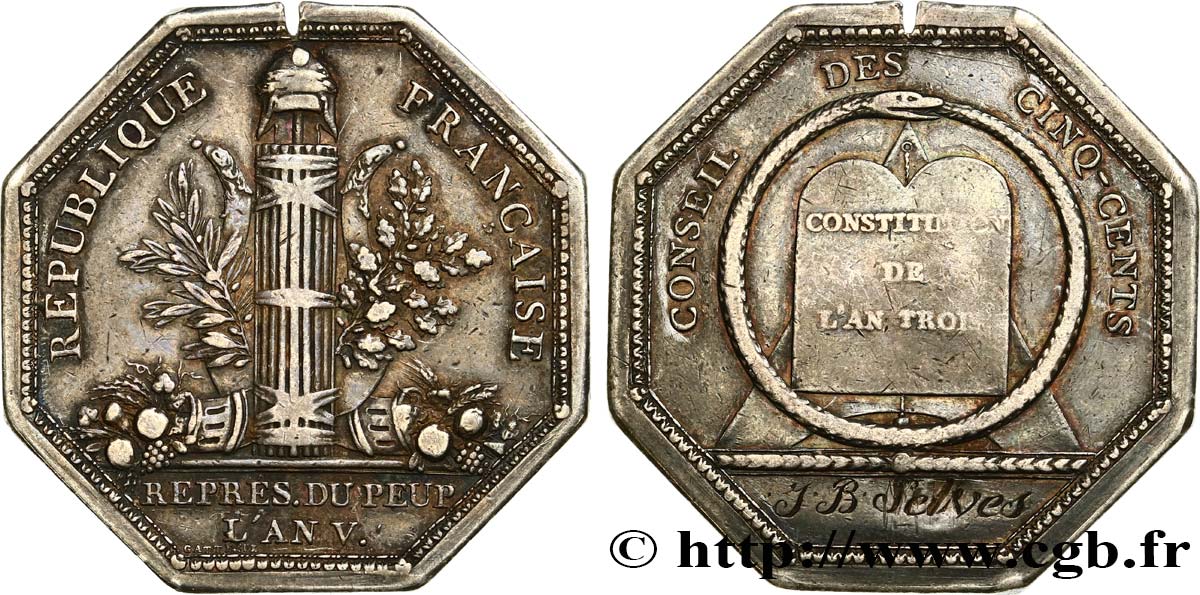
 Report a mistake
Report a mistake Print the page
Print the page Share my selection
Share my selection Ask a question
Ask a question Consign / sell
Consign / sell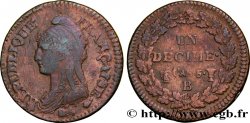
 Full data
Full data

